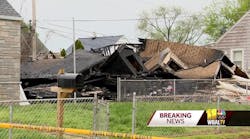“Interior structural firefighter” is the gold standard in the American fire service. Most people who join a fire department do so with visions of entering burning buildings, wearing self-contained breathing apparatus (SCBA) and performing the numerous tactics required inside these structures. But in addition to those interior tactics, there is a whole set of tactics that are conducted outside the building. Let’s take a look at what I like to call “outside work.”
Outside work is the group of activities that are and can be performed by firefighters while they remain outside of immediately dangerous to life or health (IDLH) areas or smoke. These tactics are most often performed by firefighters who, after completing them, enter the building and continue firefighting operations. In a smaller number of departments, there are interior-qualified firefighters who enter the building and there are other firefighters who are not yet trained, qualified or permitted to enter the building. In these departments, this list of outside work contains many of the jobs that they can perform which allows the interior firefighters to enter the structure and fight the fire.
• Size-up. Size-up is the mental evaluation of conditions that we encounter when we arrive at an operation. Actually, good size-up begins when we are dispatched and continues when we arrive on scene. Many chief and company officers conduct a “360 size-up,” which entails taking a lap around the involved structure and noting any fire, structural or other conditions that may play a role in the development of a solid strategy. Interior conditions reported to the incident commander outside can also be considered.
• Ladder work. We find portable ladders on just about every fire apparatus we encounter. Ladder trucks, aerial and tower ladders and tillers have a full assortment of portable ladders. City-service ladder trucks have a good assortment too without the aerial ladder or basket. Engines too, if properly equipped, will have several portables.
Portable and aerial ladders are used for access to many areas at a building fire: window access for ventilate-enter-search (VES) operations with the tip at or under the sill; roof access with the tip four or even five feet above the ladder/roof contact point; and to fire escape balconies, rear and side decks and sometimes the front porch. To safely and effectively use portable ladders, you must have a handle on several skills. These include selecting the proper length, positioning the tip correctly, proper climbing, tool carrying, getting on and off the ladder properly and effective carrying, raising and maneuvering skills.
• Ventilation. This is one of the most misunderstood tactics in the fire service. There are many different types of ventilation that should be carried out at many different time during a fire operations. Vertical ventilation, or opening the top of the building, is a basic yet important ventilation method. In flat roof buildings, both commercial and residential, you can cut the roof for a fire either on the top floor or right under the roof in the attic or cockloft. Another vertical vent tactic is to get to the roof and open skylights, scuttle covers or even the door at the roof bulkhead. Vertical roof ventilation, although an outside operation requires the firefighter to get to and operate on the roof. We are close to being inside at this point but this is still outside work.
Horizontal ventilation is most often performed by breaking the windows on the fire floor, both at the fire area and remotely. There are some rules that must be followed because interior firefighters can be endangered by the breaking or venting of windows by a firefighter on the outside of the building. Always talk on the radio about what you are about to vent so others can evaluate the effect it may have on them.
• Defensive hoselines. At large-scale exterior operations, firefighters are often required to man exterior hoselines and master steams. Master streams may be apparatus mounted or portable. Due to the flow required and expected of these devices, portable master streams are almost always supplied with a larger than 2½-inch hoseline. On the other hand, exterior defensive handlines should not generally be smaller or larger than 2½ inches in diameter. A 1¾-inch handline does not have the flow or reach that can be attained with a 2½-inch line and a line larger than 2½ inches would almost be impossible to handle or advance by the nozzle team.
All of the tactics described here are vital to the outcome of the operations where they are being conducted. Size-up, portable ladder operations, ventilation and defensive handline tactics can have a dramatic positive effect on a structural fire operation. Fire departments where the staffing limits the ability of the on-scene personnel to perform these jobs also limit the chances of the operation coming to a successful conclusion.






